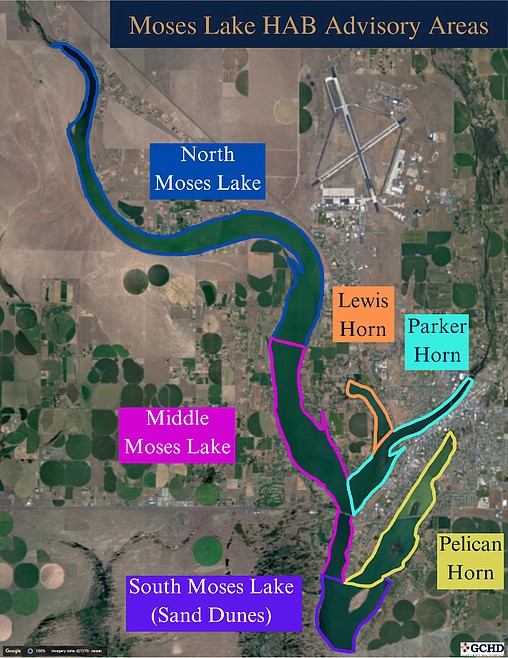Health District outlines new plan for blue-green algae
MOSES LAKE — A new system for monitoring blue-green algae in Moses Lake will be rolled out this year, according to a press release from the Grant County Health District.
Moses Lake will now be divided into six sections for monitoring and sampling purposes: North Moses Lake, Lewis Horn, Parker Horn, Middle Moses Lake, Pelican Horn and South Moses Lake, which includes the Sand Dunes, according to the press release. A group of volunteers called the Cyanobacteria Surveillance by Citizens, Users, and Managers (CSCUM) will monitor and sample potential blooms at various points in each section.
One major advantage of this initiative is the ability to issue targeted advisories and warnings for a specific area of the lake rather than an advisory encompassing the entire body of water, the press release said.
“This pilot project has been a goal of GCHD’s for quite some time and we couldn’t have done it without the help of our willing volunteers and community partners, especially the Columbia Basin Conservation District,” GCHD Environmental Health Manager Stephanie Shopbell wrote in the press release. “We are thrilled to see it come to life!”
Volunteers will record and submit their findings using an app, according to the press release. That information will be uploaded to a map that was created in collaboration with the Columbia Basin Conservation District and Moses Lake Watershed Council. Results will then be made accessible to the public, allowing residents and visitors to make informed decisions before committing to a day on the water. Volunteers will make observations at each site weekly throughout the summer and early fall. Results can be found on GCHD’s Blue-Green Algae Monitoring page: https://bit.ly/MLalgae. Anybody who would like to volunteer can also register at the same site.
Blue-green algae blooms grow rapidly in fresh water when there is enough sunlight, high temperatures, and nutrients in the water, the press release said. It often looks like green paint floating on the water. It is common for Grant County waters to have blue-green algae in the summer and fall, but not all blue-green algae blooms are toxic.
Currently, there is a water quality warning advisory for the Perch Point area on Potholes Reservoir. GCHD has also received reports of suspected blue-green algae bloom on Westshore Drive in Moses Lake. No blooms were observed at either Blue Heron Park or Connelly Park by volunteers and no toxin samples were taken.
GCHD recommends residents:
• Avoid areas of scum when boating, swimming or water skiing
• Avoid drinking lake water
• Keep pets and livestock away from these areas
• Clean fish well and discard guts
The type of blue-green algae commonly found in Grant County lakes produce Microcystin toxin, which can cause serious illness in people, pets, and livestock, the press release said. Symptoms may take 30 minutes to 24 hours to appear, depending upon the size of the person or animal affected and the amount of toxic bloom consumed. Microcystin toxicosis may include jaundice, shock, abdominal pain/distention, weakness, nausea/vomiting, severe thirst, rapid/weak pulse and death.
GCHD hopes eventually to expand this pilot project beyond Moses Lake and implement a similar monitoring system on other Grant County lakes known for annual blue-green-algae blooms, according to the press release.



